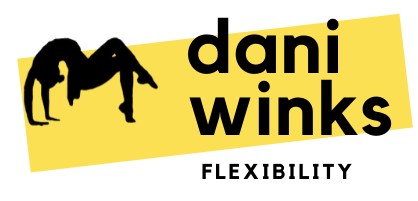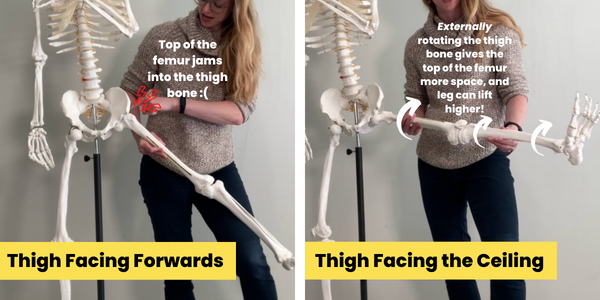Help! My Outer Hips Hurt When I Straddle
Help! My Outer Hips Hurt When I Straddle
Straddles, like middle splits, are mainly meant to stretch your adductors (inner thigh muscles) and/or your hamstrings if you’re taking it into a straddle pancake forward fold - so if you’re feeling pain or discomfort in the outside of your hips, and not a stretching sensation on your inner thighs, something needs to change!
The most common reason for straddles and middle splits to feel like a literal pain in the but, sometimes described as a “pinching” sensation, is due to improper alignment that causes the top of your thigh bone to crunch into your hip bones. When we have bone hitting on bone, that’s a hard blockage that no amount of stretching will help you push through! Instead, you have to adjust your alignment.
Hip Joint Anatomy 101: The Bones
First a quick review of what the bones of our hip joint actually look like (because this is important):
Our “hip joint” is a ball-and-socket joint that connects our pelvis (hip bones) to our femur (thigh bone)
The head (ball) of the femur nestles into the acetabulum (socket) of the hip bone and is held in place by several crisscrossing ligaments (not shown)
There’s a big club-y protrusion, the greater trochanter, that sticks out of the top of the thigh bone and serves as the attachment site for several muscles
There are also obviously a bunch of ligaments and muscles involved as well, but for the purposes of this post we’re just going to focus on the bones and avoiding bone-crunching-into-bone situations.
Bone Crunching Example: Standing Hip Abduction (Lifting a Leg Out to the Side)
Let’s take a look at a simpler movement first to better understand the boney structures involved in hip movement: lifting a leg out to the side. If, starting from standing, you try to lift one leg directly out to the side while keeping your thigh and knee facing forwards, odds are you can’t lift it very high without tilting your hips. You’ll quickly run into a point where the big club end of your thigh bone (the greater trochanter of the femur) bonks into the outside of the hip bone socket and you literally can’t move the leg without tilting your hips to the side. However if you rotate your thigh and knee to face the ceiling, this sends the big club end of the top of your thigh bone backwards where there’s more space so it doesn’t smash into your hip bone. That’s why you can lift your leg higher when your thigh bone is facing the ceiling! Moral of the story: we need to rotate the thigh to allow for the most space in our hip joint to let us lift our leg higher to the side.
What’s This Look Like in a Seated Straddle?
When we’re sitting in a straddle, we want to avoid that same bone-on-bone crunching that can happen when either the neck or the greater trochanter (big club part) of our thigh bone hits our hip bones. For most people, that means making sure our hips are in a neutral, or slightly forward tilted position, while our thigh bones are in a neutral, or slightly backwards/externally rotated position.
If your hips are slightly tucked, or tilted backwards (which can commonly happen if you have tight hamstrings), this brings our thigh bones into a more internally rotated position, which can cause that bone-on-bone blockage when you try to open your legs out to the side:
To avoid this, we need to either externally rotate the thigh bones (rotate them backwards), and/or tilt the hip bones forwards to give more space for our thigh bones to open out to the sides.
From a practical perspective, that means:
Slightly tilting your hip bones forwards (you can imagine you’re slightly rounding your low back) before you open your legs to your widest straddle (aka flexing your hips)
If you can’t tilt your hips (ex. you have tight hamstrings that are keeping you stuck in a posterior pelvic tilt), elevate your hips by sitting on a block or a chair and/or bend your knees to make it easier to slightly tilt your hips forwards. Then open your legs out to the side
What About Middle Splits?
If you read my Straddle vs. Middle Split - What’s the Difference? blog post, you’ll remember that our hip and thigh position (relative to each other) in a straddle and middle split are the same. That’s right, your straddle and your middle split are virtually the same shape! The only difference is in a straddle we keep our butt on the floor, and in a middle split our butt is lifted and we rotate the entire shape 90 degrees. If you did your middle split with your butt and legs pressing into a wall, then you could see that you’re basically doing a straddle against the wall!
So what does that mean for hip bone and thigh bone position? Just like in a seated straddle, you want to try to slightly externally rotate your thigh bones in relation to your hip bones - and that’s easiest done by trying to tilt the top of your pelvis forwards. If you typically feel “crunching” or “pinching” in the outside of your hips when you slide out into your middle split, try slightly arching your lower back and tilting the top of your hips forwards towards the floor (lifting your tailbone slightly) before sliding your legs out to the sides, that will bring us into more external hip rotation and for most people’s hip anatomy, that will give you the most space in the hip joint to open the legs.
Hopefully making those adjustments help lessen any unproductive, pinching sensations in the outside of your hips, and instead allow you to feel the stretch in your inner thighs (and/or your hamstrings).




